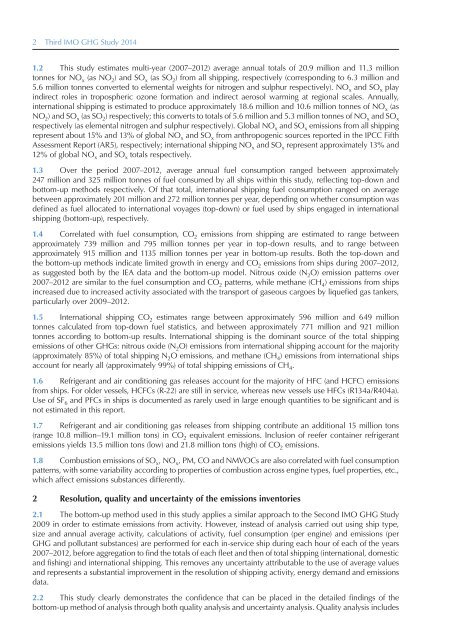Third IMO Greenhouse Gas Study 2014
GHG3%20Executive%20Summary%20and%20Report
GHG3%20Executive%20Summary%20and%20Report
You also want an ePaper? Increase the reach of your titles
YUMPU automatically turns print PDFs into web optimized ePapers that Google loves.
2 <strong>Third</strong> <strong>IMO</strong> GHG <strong>Study</strong> <strong>2014</strong><br />
1.2 This study estimates multi-year (2007–2012) average annual totals of 20.9 million and 11.3 million<br />
tonnes for NO x (as NO 2 ) and SO x (as SO 2 ) from all shipping, respectively (corresponding to 6.3 million and<br />
5.6 million tonnes converted to elemental weights for nitrogen and sulphur respectively). NO x and SO x play<br />
indirect roles in tropospheric ozone formation and indirect aerosol warming at regional scales. Annually,<br />
international shipping is estimated to produce approximately 18.6 million and 10.6 million tonnes of NO x (as<br />
NO 2 ) and SO x (as SO 2 ) respectively; this converts to totals of 5.6 million and 5.3 million tonnes of NO x and SO x<br />
respectively (as elemental nitrogen and sulphur respectively). Global NO x and SO x emissions from all shipping<br />
represent about 15% and 13% of global NO x and SO x from anthropogenic sources reported in the IPCC Fifth<br />
Assessment Report (AR5), respectively; international shipping NO x and SO x represent approximately 13% and<br />
12% of global NO x and SO x totals respectively.<br />
1.3 Over the period 2007–2012, average annual fuel consumption ranged between approximately<br />
247 million and 325 million tonnes of fuel consumed by all ships within this study, reflecting top-down and<br />
bottom-up methods respectively. Of that total, international shipping fuel consumption ranged on average<br />
between approximately 201 million and 272 million tonnes per year, depending on whether consumption was<br />
defined as fuel allocated to international voyages (top-down) or fuel used by ships engaged in international<br />
shipping (bottom-up), respectively.<br />
1.4 Correlated with fuel consumption, CO 2 emissions from shipping are estimated to range between<br />
approximately 739 million and 795 million tonnes per year in top-down results, and to range between<br />
approximately 915 million and 1135 million tonnes per year in bottom-up results. Both the top-down and<br />
the bottom-up methods indicate limited growth in energy and CO 2 emissions from ships during 2007–2012,<br />
as suggested both by the IEA data and the bottom-up model. Nitrous oxide (N 2 O) emission patterns over<br />
2007–2012 are similar to the fuel consumption and CO 2 patterns, while methane (CH 4 ) emissions from ships<br />
increased due to increased activity associated with the transport of gaseous cargoes by liquefied gas tankers,<br />
particularly over 2009–2012.<br />
1.5 International shipping CO 2 estimates range between approximately 596 million and 649 million<br />
tonnes calculated from top-down fuel statistics, and between approximately 771 million and 921 million<br />
tonnes according to bottom-up results. International shipping is the dominant source of the total shipping<br />
emissions of other GHGs: nitrous oxide (N 2 O) emissions from international shipping account for the majority<br />
(approximately 85%) of total shipping N 2 O emissions, and methane (CH 4 ) emissions from international ships<br />
account for nearly all (approximately 99%) of total shipping emissions of CH 4 .<br />
1.6 Refrigerant and air conditioning gas releases account for the majority of HFC (and HCFC) emissions<br />
from ships. For older vessels, HCFCs (R-22) are still in service, whereas new vessels use HFCs (R134a/R404a).<br />
Use of SF 6 and PFCs in ships is documented as rarely used in large enough quantities to be significant and is<br />
not estimated in this report.<br />
1.7 Refrigerant and air conditioning gas releases from shipping contribute an additional 15 million tons<br />
(range 10.8 million–19.1 million tons) in CO 2 equivalent emissions. Inclusion of reefer container refrigerant<br />
emissions yields 13.5 million tons (low) and 21.8 million tons (high) of CO 2 emissions.<br />
1.8 Combustion emissions of SO x , NO x , PM, CO and NMVOCs are also correlated with fuel consumption<br />
patterns, with some variability according to properties of combustion across engine types, fuel properties, etc.,<br />
which affect emissions substances differently.<br />
2 Resolution, quality and uncertainty of the emissions inventories<br />
2.1 The bottom-up method used in this study applies a similar approach to the Second <strong>IMO</strong> GHG <strong>Study</strong><br />
2009 in order to estimate emissions from activity. However, instead of analysis carried out using ship type,<br />
size and annual average activity, calculations of activity, fuel consumption (per engine) and emissions (per<br />
GHG and pollutant substances) are performed for each in-service ship during each hour of each of the years<br />
2007–2012, before aggregation to find the totals of each fleet and then of total shipping (international, domestic<br />
and fishing) and international shipping. This removes any uncertainty attributable to the use of average values<br />
and represents a substantial improvement in the resolution of shipping activity, energy demand and emissions<br />
data.<br />
2.2 This study clearly demonstrates the confidence that can be placed in the detailed findings of the<br />
bottom-up method of analysis through both quality analysis and uncertainty analysis. Quality analysis includes


